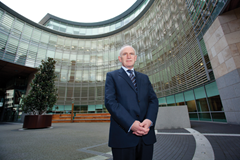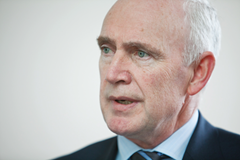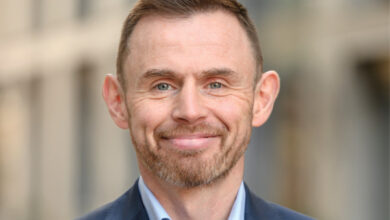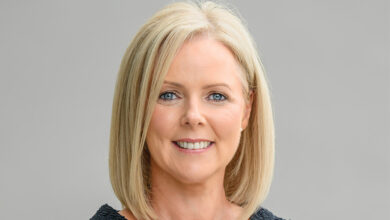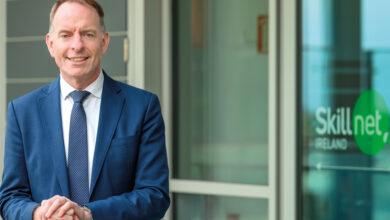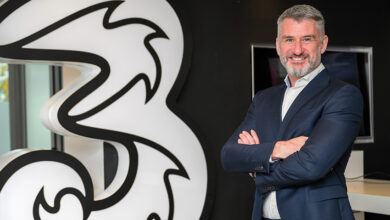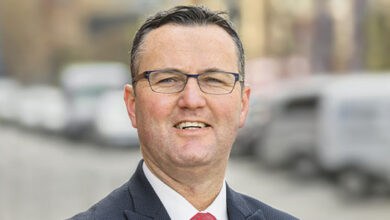EirGrid Chief Executive Dermot Byrne sums up the way ahead for energy
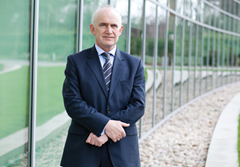 EirGrid’s Chief Executive Dermot Byrne discusses the future outlook for the Irish energy sector with Owen McQuade. He sees a number of key building blocks being put into place that will shape the sector for decades to come.
EirGrid’s Chief Executive Dermot Byrne discusses the future outlook for the Irish energy sector with Owen McQuade. He sees a number of key building blocks being put into place that will shape the sector for decades to come.
The issue that Dermot Byrne, Chief Executive of electricity grid operator EirGrid, addresses first is that of energy security. “There are a number of different dimensions to energy security, starting with generation adequacy. Have we enough generation on the island to meet demand now and into the future?” he asks.
EirGrid produces a capacity statement every year for the electricity system which is now an all-island statement, reflecting the all-island nature of the electricity market.
“A combination of things has meant that from a generation adequacy point of view, yes, we’re in good shape. There are probably some very positive reasons for this but also the fact that demand is down on what it might have been, had we not had the last five years of economic crisis.”
“We’ve also had a number of new plant commissionings over the past couple of years including the Bord Gáis plant and the ESB plant in Cork. With also more wind coming on to the system, this does contribute somewhat to security of supply.”
On a broader level, from a fuel security point of view, he sees this as “a big issue” at a European level because of the increasing dependence on imported gas into Europe from Russia. He observes that there have been a couple of experiences over the past number of years where supply to Europe has been threatened.
From an Irish point of view, Byrne believes that “because we’re moving towards more indigenous renewables, wind (both north and south) and with Corrib gas coming onstream, all of that will help towards securing our fuel supplies for a generation. Therefore we are in reasonably good shape.”
The third dimension of energy security is the electricity grid itself: “You have to have the grid there to guarantee the reliability of supply down to every county and every region.” The grid improvements under Grid 25 ensure the network is being strengthened to achieve this goal.
A fourth dimension of energy security is having a market that incentivises new generation plant “that makes sure that what needs to get built gets built.” With the evolution of the Single Electricity Market (SEM), “we’ve a lot of work to do but we’re in good shape.”
“Underpinning all of these challenges is the requirement for exceptional people and we are fortunate in both Belfast and Dublin to have people with the knowledge and commitment to deliver EirGrid’s part in the coming years.”
Regional interconnection
European energy policy is very much driving towards the integration of energy markets. “Increasingly we’re moving from a national market to a regional market for the island of Ireland. That region will expand going forward into ‘France, UK and Ireland’ and then into a wider European market. That’s very evident in the whole thrust of policy”, observes Byrne.
EirGrid is very much at the centre of the integration of the electricity markets. Firstly, the grid company is building the infrastructure required for market integration. The East-West Interconnector, which will link Ireland with Great Britain, is a major “transformational” project. The project is on target and within budget for delivery this year, “which is what we committed to do.”
“One of the things that I’m most proud of is that we have built the organisational capability to deliver a major project like that and deliver it very successfully,” says Byrne.
When the new interconnector is in service there will be 950MW capacity between Ireland and Great Britain. With the integration of the electricity market and looking to future potential exports of renewables from Ireland, is there a case for further interconnection?
Economic evaluation of the case for further interconnection shows an “a priori justification for further links to Great Britain or France.” Since that study, EirGrid has been working with both the transmission system operators (TSOs) in Great Britain and France on looking to develop further interconnection, with another study continuing in France: “so far, it’s reasonably positive”.
There are plans to further strengthen the links between the transmission grids north and south. The project has been delayed with planning issues.
“Like any piece of overhead line construction anywhere in Europe, there is obviously huge community interest in it and a lot of public opposition to it. Public acceptability of infrastructure continues to be a big issue for TSOs but also more generally for society. If we can’t build infrastructure, what happens?” asks Byrne.
EirGrid has put a “huge” effort into its communications and into the consultation processes. “Having said that, we are getting on with a lot of work on the ground under Grid25 and in a lot of cases, we are getting a lot of support. We are already delivering upgrades, which is part and parcel of the Grid25 programme, using very innovative technology such as: the high temperature, low sag conductors which have enormous capability in terms of increasing capacity by 50 per cent plus,” he observes.
Byrne notes that the larger projects tend to attract most opposition, with the North/South interconnector being “a lightning rod” in that context.
On the North/South interconnector, there was an independent expert commission report on the issue which was published and debated in Oireachtas committee in February, which was a “good, full and frank discussion around the issues”.
There is now a high degree of awareness around the issues at stakeholder level. The Minister has indicated that he will bring forward a memorandum on security of supply to Cabinet following this committee discussion and the consultation with the stakeholders.
“We’re looking forward to seeing that delivered. That will enable us to get back into the planning process where these issues, I believe, are best considered and ultimately a decision is made by An Bord Pleanala who have the role of balancing the positives from the infrastructure, the benefits that it brings in terms of jobs, in terms of reliable, secure and efficient power supply on the island of Ireland with the impacts that this infrastructure brings on the landscape and on the environment.
“We always engage in an open and proactive way with communities and landowners to help build good understanding of projects so that we can work together to manage the impacts and deliver an overall positive outcome,” he adds.
Single Electricity Market
Byrne sees the Single Electricity Market as an “overall success”.
“The SEM was a very ground breaking development back when it was first mooted, in terms of the co-operation between the two regulators north and south, and the two governments north and south.
The SEM has been “a hugely positive development” in terms of running an efficient power system on the island, with competition: “Every generator on the island of Ireland is competing against every other generator. So that does lead to downward pressure on prices, and I think it has delivered that.”
Another positive which the SEM has delivered is related to security of supply, with the right market structures to incentivise investment: “I think we have clearly seen that, the capacity payment element of the market has meant that capacity has been built and we’re now seeing other jurisdictions looking at introducing capacity payment mechanisms.”
Reflecting on future market development, he says that nothing stays the same forever and the next phase of development of the market is tied in with the East-West Interconnector (EWIC) with the introduction of intra-day trading.
This has led to two major projects: the physical interconnector; and the EWIC readiness project which will develop a trading platform for the new interconnector to interface with the GB market.
“These projects are about putting in place the arrangements to enable the benefits of both interconnectors to be realised. The auction platform covers both Moyle and EWIC interconnectors and is also the same auction platform that is used in other European interconnectors, so that traders will see a single auction platform across the bigger region: France, UK and Ireland.”
EirGrid is now very much an all-island company, with the acquisition of the System Operator Northern Ireland (SONI) in 2010, which has been “incredibly positive”.
“It has enabled a much closer working relationship with our colleagues in Belfast, which I think has been and will continue to be of benefit to customers in both jurisdictions. As part of that, EirGrid plc supplemented its board to bring on board very experienced people from Northern Ireland,” states Byrne.
The ‘memo and articles’ of the company were changed to make it clear that the whole board has responsibilities to stakeholders and customers in both Northern Ireland and the Republic of Ireland: “a very clear re-orientation of the company as an all-island company.”
The acquisition has already brought synergies. There are “very significant” benefits at a practical level. An example being the co-ordination of the procurement of wind forecasting tools, so the same tool is now used in control centres in Belfast and in Dublin.
“We have also greatly benefited from bringing the skills and knowledge of the staff in SONI into the EirGrid group.”
There have also been organisational changes which bring the operations closer together “because at the end of the day, we have a Single Electricity Market on the island of Ireland. The grid itself is a single, synchronous power system so we want to make sure that we operate that in the most efficient and most effective way possible.”
“We’re committed to a control centre in Belfast and a control centre in Dublin going forward but we’re going to look at how we’re going to make best use of those control centres for the benefit of customers and stakeholders in both jurisdictions,” says Byrne.
On the integration of the current level of renewables, Byrne sees it as “quite a staggering achievement”.
Around 17 per cent of electricity was generated from wind on the island last year and there is a target of 40 per cent from renewable sources by 2020. Part of this target will be met by hydro and biomass but the bulk of it will be wind. In both jurisdictions, most of that will be mostly onshore wind with some offshore wind, “maybe earlier in Northern Ireland due to the support mechanism”.
“Wind has its own challenges but I think that by facing those in a very positive way, we’ve been able to overcome a lot of the challenges so far. And we’re on a path towards overcoming any remaining challenges to get to the 2020 figure.
“When I tell people that already we are hitting 50 per cent at points in time, people are quite staggered by that because I don’t think that there’s any other country, as a synchronous system, doing that. I know other countries do it but they are connected into, for example, the bigger mainland European system. We are able to do this through the deployment of world leading smart grid solutions.
“Of course, that’s not enough. We need to get up to much higher levels of renewables penetration if we’re to hit the 40 per cent target. The key to enabling us to get there has been the analysis carried out by the facilitation of renewables study which again was a ground-breaking piece of work, published in 2010. Clearly we need to get from 50 per cent up to much higher levels. By 2020, I expect that there will be times when three-quarters of the electricity generated on this island is coming from wind.”
EirGrid has been working very closely with the renewables industry on this and has set up an advisory council “so that they can influence and help us to get to where we need to get to. It does require everybody to play a part in this. It isn’t just us. Compliance with grid code is a must and we need to incentivise more flexibility,” states Byrne.
Byrne says that there will be also be changes, for example, to the ancillary services regime to incentivise flexibility and we have recently consulted with industry on that. “It’s very exciting work and it’s very exciting because of the world leadership position that we have in this area.
“I think that it’s very motivating for the fantastic staff that we have both in Belfast and Dublin. There’s nothing that motivates people like a good challenge and we have that in spades in the targets we’ve set ourselves but I’ve every confidence we’ll get there.
“The next stage of that is moving towards full compliance with the EU target model. We’re very active in that space with the regulatory authorities. It’s a big challenge because the market shapes are quite different. We have a pool market and Great Britain has a bilateral market. How do you optimise the market arrangements so that you can get the required trading for the benefit of customers on both sides? There’s a really good piece of work that is out for consultation now and we’ve contributed to that,” says Byrne.
EirGrid’s long-term strategy for grid development, Grid25, is to focus on providing the solid “backbone” of the power system. The importance of which Byrne emphasises: “[This is] what allows us to harness the fantastic wind, wave and tidal resources that we have on the island.”
Without such a strategic approach, the grid would be developed on an incremental basis “which means that you end up with more kilometres of new line, perhaps not at the optimum voltage whereas if you take a strategic approach, you can build one line where previously you might have built three.”
Future
Looking to the future, the EirGrid CEO sees the coming period as a critical juncture in the development of energy in Ireland: “If I take a five-year view of the industry, the components of it are falling into place now. At the market level, it’s clear that we have the step towards intra-day trading, followed by compliance with the target model by 2016. That’s a clear roadmap for the market.”
On the operations side of the business there is also a very clear road map which is determined by the added complexity and challenges of integrating renewables, the opportunities presented by new and emerging smart grid technologies and also the North/South dimension of using both control centres in Dublin and Belfast in an optimum way.
On grid development there is Grid25 and Northern Ireland Network 25 programme which detail future development of the transmission grid on the island.
The fourth dimension is around the export of renewables from the island of Ireland to Great Britain and perhaps even beyond. EirGrid are working in the ‘north seas’ space through ENTSO-E, participating in an analysis of the economic case for offshore grid development.
In summing up, Byrne sees a “very dynamic policy space” over the next five years. The decisions made during this period will not only determine whether Ireland meets its targets for 2020, but will also shape the energy sector on the island for many decades to come.

